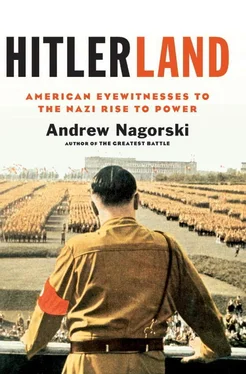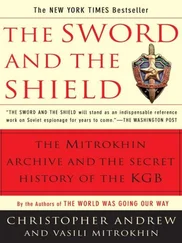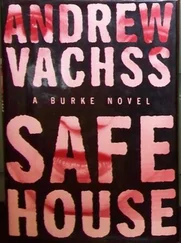
William Shirer (broadcasting for CBS in 1940) was one of the most discerning American correspondents, anti-Nazi from the beginning.

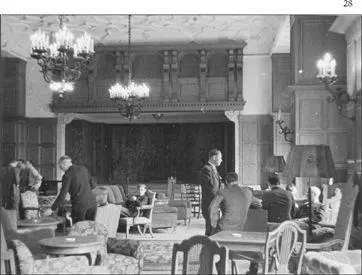
After Germany declared war on the United States on December 11, 1941, U.S. diplomats and reporters based in Berlin were interned in a deserted spa hotel in Bad Nauheim, outside of Frankfurt. The AP’s Angus Thuermer reads in his room, while other Americans pass the time in the main lobby.
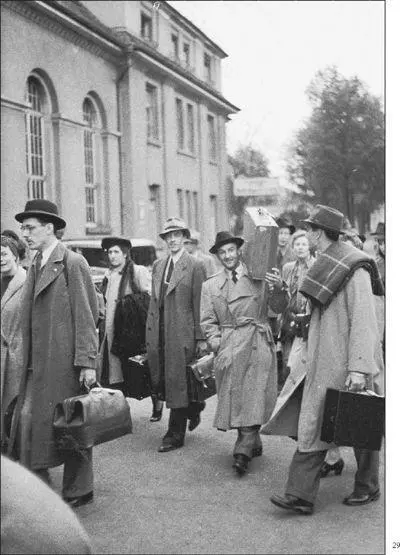
On May 12, 1942, the Americans were released from Bad Nauheim in exchange for the release of the German diplomats and journalists who had been interned in far more luxurious conditions at the Greenbrier, the plush resort hotel in West Virginia. Here, the Americans are arriving at the Bad Nauheim train station where they would begin their journey to Lisbon—and freedom.
Sometimes a book idea seems so obvious after the fact that it’s hard to recall where it originated. But I have no such problem in the case of Hitlerland. Christina, or Krysia as family and friends call her, and I were driving back to New York after visiting my parents in Washington when we began discussing what I might write about next. I mentioned that when I had worked on The Greatest Battle, I had particularly enjoyed exploring the activities and perceptions of the foreign community in Moscow as the German forces mounted their drive that nearly reached the Soviet capital. Krysia then asked the question: “Has anyone written about Americans in Germany in the 1920s and 1930s?” She pointed out that so much was written about Americans in Paris and London, but she hadn’t seen a book that recounted the experiences of their counterparts in Germany.
We had lived in Berlin and Bonn when I was reporting for Newsweek , and I thought I was reasonably familiar with the major books depicting the 1920s and 1930s, but I had never thought about that question. I knew of a few individual memoirs and histories written by Americans in Germany but couldn’t think of a book that examined their lives and perceptions in a comprehensive way. I was intrigued and soon confirmed that no such book existed. The next question was whether there would be enough sources of information to tell their story; in fact, I quickly ascertained that there were far more published and unpublished accounts, correspondence and other documents providing firsthand impressions and recollections of Americans than I had imagined.
When I started this project, there were a few people still alive who now figure in these pages, sometimes discovered almost by accident. Ina Navazelskis, a former journalistic colleague who now works at the Holocaust Museum in Washington, alerted me to the letters of Phillips Talbot, an Asian scholar who, as a young man, visited Germany in 1938. I reached Talbot by phone, and he agreed to send me copies, and we talked about his experience. He also urged me to get in touch with his old friend Angus Thuermer, who had been a young AP reporter in Berlin in the late 1930s. With the help of his daughter Kitty Thuermer, I was able to visit him and his wife, Alice, in their home in Middleburg, Virginia, interviewing him at length, obtaining a copy of his unpublished memoirs and going through his remarkable photo albums that include the photos from Bad Nauheim that appear here. Sadly, neither Talbot nor Thuermer lived to see the publication of this book.
There were also the personal acquaintances I hadn’t realized had anything to do with the subject of my book until I started running across their names in my preliminary research. Richard Hottelet, the retired television correspondent who was one of the original “Murrow boys,” was someone I had known for quite some time. But I only discovered when I began my research that he had served in Berlin for United Press in the early period of World War II and ended up imprisoned by the Gestapo; although he was dealing with some health problems, he immediately agreed to be interviewed. Similarly, I hadn’t known that the late Jacob Beam, the father of my friend and journalistic colleague Alex Beam, had served in the U.S. Embassy in Berlin in the 1930s. Alex was able to provide me with his unpublished manuscript.
Some of the children and grandchildren of the protagonists in this book offered valuable insights and materials about those who are no longer with us. In Middletown, Connecticut, Katharine (Kätchen) Truman Smith Coley freely shared her memories of her parents, Truman and Katharine Smith, and vivid recollections of her time in Berlin in the mid-1930s as a young girl. She also allowed me to use the remarkable photo from that period showing her uneasily holding Goering’s lion; the photo had been hanging on her refrigerator. In Munich, Eric Hanfstaengl talked about his grandparents Ernst (“Putzi”) and Helen, and allowed me to use the photo of his grandmother dressed up as the Statue of Liberty and holding the American flag on the steps of Hoboken’s City Hall. Two granddaughters of Louis Lochner—Anita Lochner, who lives in Berlin, and Barbara Roth, who lives in Geneva—extended their assistance, too. To everyone with those kinds of personal connections, I’m especially grateful.
Given the passage of time, though, I had to rely mostly on the written testimonies left behind by the American eyewitnesses. Many were published at the time, although now largely forgotten. But others had never appeared in print. To track down the latter, I received help from numerous archivists and librarians at a broad array of institutions that contain the papers and other records of many of these Americans.
As in the past, I found an amazing assortment of original documents in the archives of the Hoover Institution. Thanks to the hospitality of Dave Brady and Mandy MacCalla of the Media Fellows Program, I was able to make several trips there. On my visits, archivists Carol Leadenham, Brad Bauer, Irena Czernichowska, and Zbigniew Stanczyk provided me with invaluable assistance that allowed me to keep discovering new materials. And even from afar, Brad, who is a remarkable German specialist, helped me connect the dots and fill in missing pieces. He also first put me in touch with Anita Lochner and Kätchen Coley.
I want to thank another former journalistic colleague, John Daniszewski of the Associated Press, for connecting me with Valerie Komor, who runs that organization’s archives. Valerie immediately offered her help, and so did her colleague Sam Markham. It was a particular pleasure to find Sam there; he was a young boy when his family and ours were friends and neighbors in Bonn in the mid-1980s. I want to thank Carol Kahn Strauss at the Leo Baeck Institute for putting me in touch with Frank Mecklenburg, the chief archivist, who immediately tipped me off to a fascinating travel diary. I also received help from many others in places like the Library of Congress and Columbia University’s Rare Book and Manuscript Library; I apologize for not listing everyone here.
As I would tell others about what I was doing, I would often get valuable leads from unexpected sources. In the Hoover archives, I was changing places at the copying machine with John McLaughlin, who, it turned out, had written his Ph.D. dissertation on Albert Wedemeyer—and promptly helped me locate Wedemeyer’s records from his time at the German War College. David Marwell, the director of the Museum of Jewish Heritage in New York, shared his dissertation on Ernst (“Putzi”) Hanfstaengl. Richard Wilson, who teaches architectural history at the University of Virginia, tipped me off to Philip Johnson’s experiences in Germany in the 1920s, and Bill Ury led me to explore the early days of the Experiment in International Living in Germany. John Birkelund urged me to check out the warnings of Ferdinand Eberstadt on the German debt deals as the Depression hit.
Читать дальше
